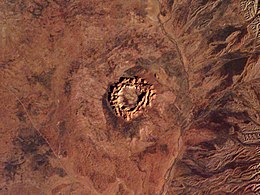| Gosses Bluff impact structure | |
|---|---|
| Tnorala | |
 View of Gosses Bluff impact structure | |
| Impact crater/structure | |
| Confidence | Confirmed |
| Diameter | 22 km (14 mi) |
| Age | 142.5 ± 0.8 Ma Early Cretaceous |
| Exposed | Yes |
| Drilled | Yes |
| Location | |
| Location | Namatjira [1] |
| Coordinates | 23°49′15″S 132°18′28″E / 23.82083°S 132.30778°E |
| Country | Australia |
| State | Northern Territory |
| Municipality | MacDonnell Region [1] |
Gosses Bluff (or Gosse's Bluff) is thought to be the eroded remnant of an impact crater. [2] [3] [4] Known as Tnorala to the Western Arrernte people of the surrounding region, it is located in the southern Northern Territory, near the centre of Australia, about 175 km (109 mi) west of Alice Springs and about 212 km (132 mi) to the northeast of Uluru (Ayers Rock). It was named by Ernest Giles in 1872 after Australian explorer William Gosse's brother Henry, who was a member of William's expedition. [1]
Formation


The original crater is thought to have been formed by the impact of an asteroid or comet approximately 142.5 ± 0.8 million years ago, [5] in the earliest Cretaceous, very close to the Jurassic - Cretaceous boundary. The original crater rim has been estimated at about 22 km (14 mi) in diameter, but this has been eroded away. The 5 km (3.1 mi) diameter, 180 m (590 ft) high crater-like feature, [6] now exposed, is interpreted as the eroded relic of the crater's central uplift. The impact origin of this topographic feature was first proposed in the 1960s, the strongest evidence coming from the abundance of shatter cones. [7] In the past the crater has been the target of petroleum exploration, and two abandoned exploration wells lie near its centre. [4]
Cultural significance
The site is known as Tnorala to the Aboriginal people of the Western Arrernte language group, and is a sacred place. It is now located in the Tnorala Conservation Reserve. [8] A Western Arrernte story attributes its origins to a cosmic impact: in the Dreamtime, a group of celestial women were dancing as stars in the Milky Way. One of the women grew tired and placed her baby in a wooden basket, or turna (also known as a coolamon [9]). As the women continued dancing, the basket fell and plunged into the earth. The baby fell to the earth and forced the rocks upward, forming the circular mountain range. The baby's parents, the evening and morning star, continue to search for their baby to this day. The turna can be seen in the sky as the constellation Corona Australis. [6] [10] [11]
In popular culture
Gosses Bluff is the inspiration for the impact crater located in the fictional Mia Tukurta National Park in the novel and Amazon Prime series The Lost Flowers of Alice Hart. [12]
See also
References
- ^ a b c "Place Names Register Extract for "Gosses Bluff"". NT Place Names Register. Northern Territory Government. Retrieved 10 May 2019.
- ^ "Tnorala/Gosses Bluff". Earth Impact Database. Planetary and Space Science Centre University of New Brunswick Fredericton. Retrieved 8 April 2018.
- ^ Milton, D. J.; et al. (1972). "Gosses Bluff Impact Structure, Australia". Science. 175 (4027): 1199–1207. Bibcode: 1972Sci...175.1199M. doi: 10.1126/science.175.4027.1199. PMID 17794191.
- ^ a b Milton, D. J.; Glikson, A. Y.; Brett, R. (1996). "Gosses Bluff—a latest Jurassic impact structure, central Australia. Part 1: geological structure, stratigraphy, and origin". AGSO Journal of Australian Geology & Geophysics. 16 (4): 453–486. hdl: 10070/89299.
- ^ Milton, D. J.; Sutter, J. F. (1987). "Revised age for the Gosses Bluff impact structure, Northern Territory, Australia, based on Ar-40Ar-39 dating". Meteoritics. 22 (3): 281–289. Bibcode: 1987Metic..22..281M. doi: 10.1111/j.1945-5100.1987.tb00625.x.
- ^ a b Parks and Wildlife Commission of the Northern Territory (May 2007) [March 1997]. Tnorala Conservation Reserve (Gosse's Bluff): Plan of Management (PDF). Northern Territory Government. ISBN 978-1-920772-87-1. Archived from the original (PDF) on 6 October 2009. Retrieved 25 November 2009.
- ^ Dietz, R. S. (1967). "Shatter Cone Orientation at Gosses Bluff Astrobleme". Nature. 216 (5120): 1082–1084. Bibcode: 1967Natur.216.1082D. doi: 10.1038/2161082a0. S2CID 4279783.
- ^ NT Govt parks and reserves
- ^ Salleh, Anna (20 September 2021). "Indigenous perspectives on country feature in Back to Nature documentary". ABC News. Retrieved 21 September 2021.
- ^ Hamacher, D. W.; Norris, R. P. (2009). "Australian Aboriginal Geomythology: Eyewitness Accounts of Cosmic Impacts?". Archaeoastronomy. 22: 62. arXiv: 1009.4251. Bibcode: 2009Arch...22...62H.
- ^ Hamacher, D. W.; Goldsmith, J. (2013). "Aboriginal Oral Traditions of Australian Impact Craters". Journal of Astronomical History and Heritage. 16 (3): 107–126. arXiv: 1306.0278. Bibcode: 2013JAHH...16..295H.
- ^ Masia, Laura (19 September 2023). "Google Searches For A Made-Up Aussie Town Have Skyrocketed After It Appeared In A New TV Show". pedestrian.tv. Pedestrian Group Pty Ltd. Retrieved 27 November 2023.


